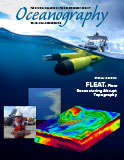Article Abstract
The interaction of large-scale oceanic flows with remote island chains can lead to turbulent wakes, enhanced vorticity production, and significant increases in biological productivity. This study showcases the range of flow conditions captured by surface current mapping high-frequency (HF) radar systems deployed around the main island group of Palau in the western Pacific. The radar array captures strong tidal and inertial flows, both near- and offshore, as well as the spatial and temporal variability associated with the synoptic geostrophic flow interacting with the island group. Surface currents measured by HF radar are significantly correlated to currents in the upper 100 m of the ocean water column, as observed with a concurrent mooring, such that the resulting surface spatial maps provide insight on the wake flows of the island across a significant portion of the upper ocean. Composite averages of eastward and westward incident flow show flow-splitting and reconnection 60 km upstream and downstream of the island group, respectively. Surface current variability observed by the radar array includes topographically blocked flow, flow separation and acceleration through passages in the island chain, eddy dipole structure, and coastal eddies with Rossby numbers of 5. The range of variability near the island chain is reflective of the complex incident flow, which encounters Palau from all directions and changes on timescales of hours to weeks. A high-resolution model qualitatively agrees with the HF radar observations and shows vorticity filaments generated downstream of the island passages.

